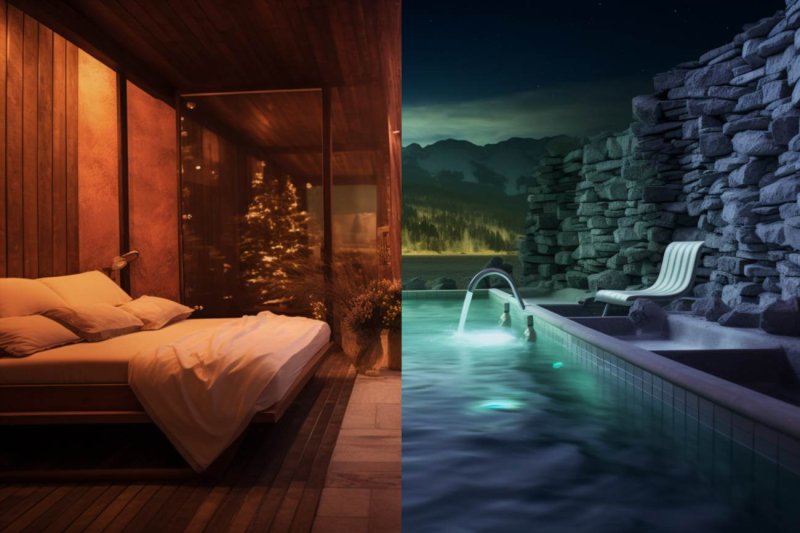Explore the disparities between a spa visit and thermal baths.
Exploring the Differences Between a Spa Visit and Thermal Baths in Budapest
When it comes to relaxation and rejuvenation, both spa visits and thermal baths offer unique experiences that cater to different preferences and needs. Budapest, often referred to as the "City of Spas," boasts a rich tradition of thermal bathing, and it's important to understand the distinctions between these two options to make the most of your relaxation time.
Spa Visit: A Holistic Retreat
A spa visit is a comprehensive wellness experience that typically encompasses a wide range of treatments, activities, and facilities. Modern spas are designed to provide guests with a holistic approach to relaxation, focusing on physical, mental, and emotional well-being. The environment is carefully curated to create a serene and luxurious atmosphere.
During a spa visit, guests can indulge in various treatments such as massages, facials, body scrubs, and more. These treatments are often personalized to individual preferences and may incorporate elements like aromatherapy, hydrotherapy, and specialized skincare products. Additionally, spas offer amenities such as saunas, steam rooms, relaxation lounges, and sometimes even fitness centers.
One of the key aspects of a spa visit is the opportunity to customize your experience. Whether you're seeking deep tissue massage to release muscle tension or a soothing mud mask to detoxify the skin, spas cater to diverse needs and preferences.
Thermal Baths in Budapest: A Historical Soak
Budapest's thermal baths, on the other hand, are deeply rooted in the city's history and culture. These baths are not just places for relaxation but also carry therapeutic benefits due to the mineral-rich thermal waters that flow beneath the city. The tradition of thermal bathing dates back centuries, and many of the baths in Budapest are architectural marvels that reflect various periods.
The thermal baths in Budapest offer a unique blend of historical charm and wellness. The waters are believed to have healing properties that can help alleviate certain health conditions such as joint pain, muscle tension, and skin issues. The experience of soaking in these ancient thermal pools amidst stunning architectural surroundings is a truly immersive journey through time.
While enjoying the thermal baths, visitors can explore different pools of varying temperatures and mineral compositions. Some baths even offer additional features like whirlpools, saunas, and cold plunge pools for a well-rounded experience.
Differences and Considerations
| Aspect |
Spa Visit |
Thermal Baths in Budapest |
| Focus |
Overall well-being and relaxation |
Historical and therapeutic experience |
| Treatments |
Customized spa treatments |
Natural thermal water soak |
| Atmosphere |
Luxurious and holistic |
Historical and cultural |
| Additional Facilities |
Saunas, steam rooms, fitness centers |
Whirlpools, saunas, plunge pools |
Frequently Asked Questions
Can I experience both a spa visit and thermal baths during my trip to Budapest?
Yes, absolutely! Budapest offers both spa facilities and historical thermal baths, so you can enjoy the best of both worlds.
Are the thermal baths suitable for individuals with certain health conditions?
Yes, the mineral-rich waters of the thermal baths are believed to have therapeutic benefits. However, it's recommended to consult with a medical professional if you have specific health concerns before visiting.
What should I bring for a spa visit or thermal bath experience?
For a spa visit, bring swimwear and any personal care items you prefer. For thermal baths, a swimsuit, a towel, and flip-flops are recommended. Some baths provide rental services for towels and swimsuits.
Can I enjoy the thermal baths even if I'm not a strong swimmer?
Absolutely. Many of the thermal baths have pools with varying depths, and some are designed for soaking and relaxation rather than swimming.

Budapest: Experience a Unique Nightlife at Széchenyi Thermal Spa Party
Discover an extraordinary nightlife experience at the iconic Széchenyi Thermal Spa in Budapest. Immerse yourself in the city's rich spa culture with a modern twist, as you join the ultimate late-night spa party.
Highlights
- Spend an unforgettable night at Budapest's renowned Széchenyi Thermal Spa
- Party from 9:30 PM to 2 AM in water temperatures ranging from 34-38 degrees Celsius
- Embrace the fusion of traditional Hungarian spa culture and a lively modern atmosphere
- Choose from various ticket options tailored to your preferred style of partying
Description
Experience a harmonious blend of Budapest's traditional and contemporary spa scene at The Széchenyi Spa. Delight in a range of alcoholic and non-alcoholic beverages available at the bars. Select the spa ticket that aligns with your partying preferences, granting you access to change rooms and locker facilities. Once you've transformed into your party attire, take to the dance floor or the water for an evening of lively entertainment.
Commence your night at 9:30 PM and dive into Budapest's vibrant nightlife and bath culture in a truly exceptional way. Conclude your evening at 2 AM, invigorated from the perfect balance of relaxation and excitement.
Includes
- Széchenyi Spa Party admission ticket
- Locker or cabin based on your chosen ticket option
- Drink coupons in accordance with your selected ticket
- Pair of slippers as per your chosen ticket
Important Information
Before you go, remember to bring your passport or ID card, swimwear, a towel, and flip-flops. It's important to note that weapons, sharp objects, outside food and drinks, as well as alcohol and drugs, are not permitted within the premises. Slippers or flip-flops are mandatory, and the last entry is at 1 AM. Payment at the bars can be made using SpartyPay Cards.
The Popularity of Thermal Baths in Budapest
Budapest, often referred to as the "City of Spas," has gained worldwide acclaim for its stunning thermal baths and rich bathing culture. With a history dating back to the Roman times, these thermal baths offer not only relaxation but also a glimpse into the city's intricate past.
The thermal baths in Budapest are renowned for their unique blend of historical charm and modern comfort. The city is blessed with an abundance of natural thermal springs, which have been utilized for their therapeutic properties for centuries. As a result, Budapest boasts a wide array of thermal baths, each with its own distinct character and offerings.
A Glimpse into the History:
The tradition of thermal bathing in Budapest can be traced back to the Roman era when the settlement of Aquincum, located on the site of present-day Budapest, was a thriving Roman city. The Romans were among the first to recognize the healing benefits of the thermal springs and constructed bathhouses around them.
However, it was during the Ottoman rule in the 16th century that the city's bathing culture truly flourished. The Ottomans, who greatly valued the therapeutic effects of hot springs, left an indelible mark by constructing magnificent bathhouses like the Rudas Baths, which still stand today.
Iconic Thermal Baths:
Budapest is home to several iconic thermal baths, each offering a unique experience:
| Name |
Features |
| Gellért Baths |
Famed for its stunning Art Nouveau architecture and elaborate mosaics. |
| Szechenyi Baths |
One of the largest medicinal bath complexes in Europe, known for its outdoor pools. |
| Király Baths |
Ottoman-era bathhouse with a traditional Turkish octagonal pool. |
| Rudas Baths |
Features a unique mix of Ottoman architecture and modern spa facilities. |
Modern Appeal:
While these baths pay homage to their historical roots, they have also evolved to cater to modern preferences. Visitors can enjoy a range of services, including spa treatments, saunas, steam rooms, and even underwater gymnastics classes. The thermal baths continue to be a hub for social interaction and relaxation, attracting both locals and tourists.
Széchenyi Spa Full Day with Optional Pálinka Tour
Experience the ultimate relaxation at Széchenyi Spa, Budapest's renowned thermal bath complex. Immerse yourself in the soothing waters of this Neo-baroque style spa, featuring 3 outdoor and 15 indoor pools with temperatures ranging from 18 to 38 °C (64 to 100 °F).
Highlights:
- Enjoy a full day at the spa, Europe's largest thermal spring bath complex
- Indulge in the spa's various pools, saunas, and steam baths
- Enhance your visit with an optional guided tour and tasting at the Palinka Experience
About the Spa:
Széchenyi Spa, established in 1913, boasts an impressive history and architecture. Originally private baths, the spa expanded over the years to encompass the opulent complex it is today. With its 3 outdoor and 15 indoor pools, Széchenyi Spa offers a rejuvenating experience that's unmatched in Budapest and Europe.
Discover the Art of Pálinka:
Opt for an enriching experience by partaking in an optional guided tour at the Palinka Museum. Explore the history and culture of Hungary through its famous spirit, "pálinka." Delight your senses with an interactive tasting tour and uncover the essence of this cherished Hungarian tradition.
Important Information:
Towels and swimsuits are available for purchase. Note that swimsuits covering the entire body are not permitted. Keep in mind that the complex covers 6220 square meters (67000 sq ft) and includes not only pools but also saunas and steam baths.
Reserve your spot today and prepare for a day of relaxation and cultural exploration at Széchenyi Spa, where the past and present of Hungary's bathing traditions harmoniously blend.
Differences in Tradition and Philosophy between Spas and Thermal Baths in Budapest
Budapest, often referred to as the "City of Baths," boasts a rich history of thermal waters and wellness culture. The city is home to numerous spas and thermal baths, each with its own distinct tradition and philosophy. These establishments not only offer relaxation and rejuvenation but also reflect the intertwining threads of history, culture, and healing. Let's delve into the intriguing differences that characterize the traditions and philosophies of spas and thermal baths in Budapest.
Historical Roots
The origins of Budapest's thermal baths can be traced back to Roman times when the city was known as Aquincum. The Romans highly valued the therapeutic properties of thermal waters and established bathing facilities. Over the centuries, as different cultures and rulers left their mark on the city, the bathing tradition evolved.
Spas, on the other hand, are a more recent phenomenon, often associated with luxury and leisure. The concept of a spa as a holistic wellness retreat gained prominence in the 18th century. These establishments aimed to provide not only physical rejuvenation but also mental and emotional relaxation.
Philosophy of Healing
Thermal baths in Budapest have a deeply ingrained philosophy of natural healing. The thermal waters that flow beneath the city are rich in minerals and are believed to have therapeutic effects on various ailments, including musculoskeletal issues and respiratory problems. The baths are often seen as places of medicinal value, where visitors come to seek relief and healing.
Spas, in contrast, focus on a broader sense of well-being. They offer a range of treatments, including massages, facials, and body scrubs, aiming to provide relaxation and enhance beauty. While many modern spas do incorporate natural elements like mineral-rich mud or hot springs, the emphasis is on creating a luxurious and pampering experience.
Architectural Styles
The architecture of Budapest's thermal baths reflects the different eras and architectural styles that have influenced the city. The Széchenyi Thermal Bath, for instance, boasts a neo-baroque design that harks back to the 19th century, while the Gellért Thermal Bath showcases Art Nouveau elements that were popular in the early 20th century.
Spas, in their pursuit of opulence, often feature lavish and contemporary designs. Modern spas prioritize comfort and aesthetics, with sleek lines, tranquil spaces, and state-of-the-art facilities that cater to the senses.
Social and Cultural Aspects
Thermal baths in Budapest hold a significant place in the city's social fabric. They have historically been gathering places for both locals and tourists, serving as venues for relaxation, socialization, and even cultural events. The communal aspect of thermal baths fosters a sense of community and shared experience.
Spas, on the other hand, often prioritize individual experiences. They offer private treatments that focus on personal well-being and are frequented by those seeking solitude and serenity.
Differences in Services and Treatments Available in Spas and Thermal Baths in Budapest
Budapest, often referred to as the "City of Spas," is renowned for its rich thermal waters and a plethora of spa facilities. Visitors flock to this enchanting city to experience the soothing and rejuvenating effects of its thermal baths. However, not all spa experiences are created equal. In Budapest, you can find a wide array of services and treatments, each offering a unique experience tailored to your preferences and needs.
Traditional Thermal Baths
When you think of Budapest's thermal baths, the iconic Széchenyi and Gellért Baths likely come to mind. These historic venues offer traditional thermal experiences. You can soak in the mineral-rich waters, surrounded by grand architecture and stunning mosaics. The services here focus on the therapeutic properties of the thermal waters, promoting relaxation and healing.
Medical Spas
Budapest also boasts several medical spas, where the emphasis is on treatments prescribed by doctors. These spas cater to individuals seeking relief from specific medical conditions. Common treatments include hydrotherapy, physiotherapy, and electrotherapy. The facilities are equipped with state-of-the-art medical equipment, and professional staff ensures that visitors receive personalized care.
Luxury Spa Resorts
For those looking for a more indulgent experience, Budapest offers a selection of luxury spa resorts. These establishments combine the healing properties of thermal waters with high-end amenities. Expect services like massages, facials, and body wraps, all delivered in opulent surroundings. It's the perfect way to pamper yourself and unwind in style.
Beer and Wine Spas
Budapest's spa scene is not limited to traditional treatments. The city is also home to unique beer and wine spas. In these unconventional settings, you can soak in baths filled with hops or wine, believed to have rejuvenating properties. It's a fun and novel way to enjoy the benefits of thermal waters while sipping on your favorite beverages.
Cultural Baths
If you're interested in experiencing Budapest's thermal culture authentically, consider visiting one of the smaller, less touristy baths. Rudas Bath, for example, has an Ottoman-era atmosphere with its octagonal pool and Turkish dome. Lukács Bath, on the other hand, is known for its artistic and literary gatherings. These baths offer a glimpse into the city's rich history while providing therapeutic treatments.
The Health Properties of Spa and Thermal Bath Treatments in Budapest
Budapest, the capital of Hungary, is renowned for its rich history, stunning architecture, and vibrant culture. But beyond these attractions, the city is also celebrated for its exceptional thermal bath and spa offerings. The thermal baths in Budapest have not only been a source of relaxation and rejuvenation for centuries, but they also offer a range of health benefits that make them a popular choice among locals and tourists alike.
These thermal baths are built upon the city's unique geological features. Budapest sits atop a network of natural thermal springs that have been tapped into to create these wonderful spa complexes. The thermal waters that flow into these baths are rich in minerals such as calcium, magnesium, and sulfur, which are known for their therapeutic properties.
Historical Significance
The tradition of thermal bathing in Budapest dates back to the Roman era when the city was known as Aquincum. The Romans were among the first to recognize the healing properties of the thermal springs. Over the centuries, various cultures and civilizations have left their mark on the city's bathing culture, resulting in a diverse range of bathhouses that showcase different architectural styles and experiences.
Health Benefits
The health benefits of spa and thermal bath treatments in Budapest are numerous and well-documented. The mineral-rich thermal waters are believed to aid in various physical and mental conditions:
- Relief for Muscular Pain: The warm waters of the baths can help relax muscles and relieve tension, making them particularly beneficial for those suffering from muscle aches and pains.
- Skin Conditions: The minerals in the thermal waters can contribute to the improvement of certain skin conditions, such as psoriasis and dermatitis.
- Improved Circulation: The heat of the water and the minerals it contains can promote better blood circulation, which is essential for overall cardiovascular health.
- Stress Reduction: The calming environment of the thermal baths combined with the effects of the warm water can have a soothing effect on the mind, helping to reduce stress and anxiety.
- Respiratory Benefits: The steam rooms found in many of Budapest's thermal baths can provide relief for respiratory issues like asthma and bronchitis.
Popular Thermal Baths in Budapest
Budapest is home to a variety of thermal baths, each with its own unique characteristics and charm:
| Name |
Features |
| Szechenyi Thermal Bath |
One of the largest and most famous baths, known for its stunning architecture and outdoor pools. |
| Gellert Thermal Bath |
Located in a historic Art Nouveau building, it offers an elegant and soothing atmosphere. |
| Rudas Baths |
Famed for its Ottoman-style architecture and a unique rooftop pool offering panoramic views of the city. |
Comparison of Atmosphere and Decor in Thermal Baths and Spas in Budapest
When it comes to indulging in relaxation and rejuvenation, few places rival the enchanting thermal baths and spas in Budapest. The Hungarian capital is renowned for its rich history, stunning architecture, and of course, its world-famous thermal waters. Visitors from all corners of the globe flock to Budapest to immerse themselves in the unique atmosphere and luxurious decor of these iconic establishments.
Atmosphere:
The atmosphere in Budapest's thermal baths and spas is truly something to behold. The moment you step inside, you are transported to a realm of tranquility and serenity. The soothing sound of trickling water, combined with the gentle echo of laughter and conversation, creates an ambiance that instantly puts you at ease. The warm embrace of the thermal waters, known for their therapeutic properties, further enhances the overall atmosphere, melting away the stresses of modern life.
Each thermal bath and spa in Budapest has its own distinct atmosphere. Some exude an air of grandeur and elegance, reminiscent of a bygone era when these baths were frequented by royalty. Others embrace a more modern and vibrant vibe, with contemporary design elements that appeal to a younger crowd. Regardless of the specific ambiance, a pervasive sense of relaxation and well-being is a common thread that ties all of Budapest's thermal baths and spas together.
Decor:
The decor of Budapest's thermal baths and spas is a captivating fusion of history and luxury. Ornate architecture, often featuring intricate mosaics, stained glass windows, and towering columns, transports visitors to a world of opulence. The decor pays homage to the rich cultural heritage of Hungary, with nods to both Roman and Ottoman influences that have shaped the country's history.
One of the most iconic thermal baths in Budapest, the Széchenyi Thermal Bath, boasts a neo-baroque architectural style that evokes a sense of grand majesty. The Gellért Thermal Bath, on the other hand, features Art Nouveau design elements that add a touch of elegance and sophistication to the bathing experience. The contrast in decor styles among the various baths allows visitors to choose an atmosphere that resonates with their personal preferences.
Modern spas in Budapest seamlessly blend historical charm with contemporary luxury. Natural materials, such as wood and stone, are often incorporated into the decor to create a harmonious connection with the natural thermal waters. This fusion of old and new not only enhances the aesthetic appeal but also contributes to the overall sense of relaxation and rejuvenation.






